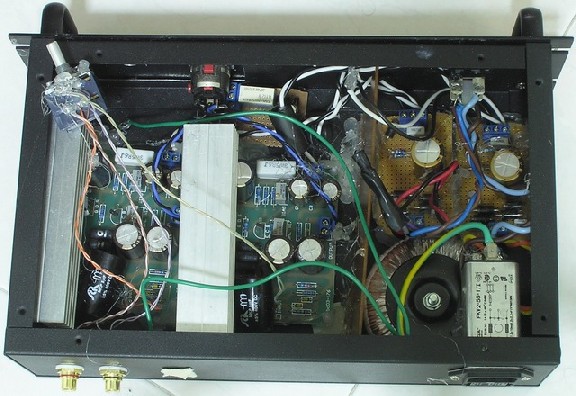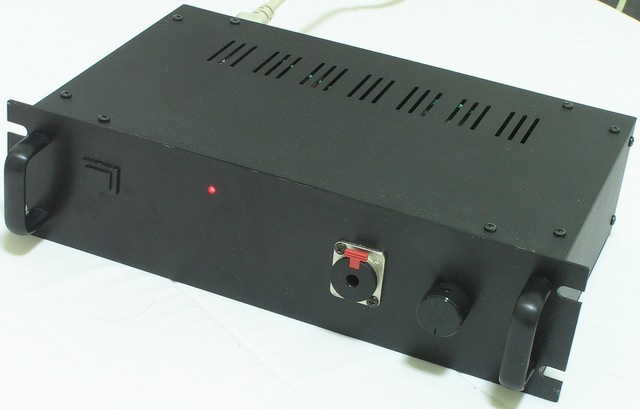
jtfoo
-
Content Count
452 -
Joined
-
Last visited
Posts posted by jtfoo
-
-
A new thread would be better. Would be helpful if you could also list the shops that has the chemical and board too.
-
Nice PCB...Good work...
-
I did had the idea of using the chassis for heat dissipation at 1st, but the chassis I got has rough surfaces. rough surface doesn't give full contact area for adequate heat transfer. Those heat sink I got are the largest I can find that is able to fit into my casing.
Not an audiophile, so I can't describe the sound in any audiophile terms. When I listen to rock music, this amp is very exciting with the Grados. I guess it drives low impedance headphone well. High impedance like my Beyer DT880 sound rather dull. Does my Grado sounds better on the Zen than PPA? A definite yes.
-
The porn. Very messy cabling.. I did made an effort to shield the transfomer from the amp PCB. Those heatshinks get very hot to touch after 20mins..
Some details on the components,
PCB : From forumer Digi01 whom can be found at headfi, headwize or diyaudio forum
Caps : PSU - nichicon generic
. PCB - Panny FC, Elna Silmic, and Solen for input coupling.
Cable : Power and grounding(green cable) - Generic copper wire stripped from computer power cord.
Input cable: Cat 5 cable from Belden ????
Output cable : Stripped from Kimber 4tc speaker cable.
Volume : 10K Alps Blue
Others: Ferrite sleeves on all power cable, Filtered IEC socket
-
-
It is based on the Zen Headphone amplifier from headwize. http://headwize2.powerpill.org/projects/sh...llerano_prj.htm
Had been listening to it for about a week. This amp drives my GradoSR125 very well. Much better than the PPA driving the Grado,but doesn't sound too exciting on the Beyer DT880.
So for Grado, this is my fave amp yet.
-
Get a playboy lol... JK.Why pay for a mag when you can get free from the net..

Anyway, I'll try to read at least the 1st few pages first asap.. I'm too impatient
-
Somebody within us has bought this book.
Wah who ar??

Till now haven't started reading it yet.. Didn't realise got so many words, thought mostly pictures.
-
After searching for a while, Im thinking about the Jan Meier PSU design. But it is fixed at 30Vpp. Any idea how to change it to be variable between 12Vpp and 30Vpp?Link over here. http://headwize2.powerpill.org/projects/sh...=meier3_prj.htm
Read the datasheet of LM317 and LM337. Read the application hint, you'll learn something from there..
-
if you want to measure ripple, put a large value cap in series with your ac meter and measure the supply. the dc cap would filter out the DC leaving the variation in the supply. the reading you get would be the RMS of the ripple. i`ve got a scope and it really doesn`t help much other than tell you that there is ripple
Your scope not useful ar... Then sell to me cheap cheap.. I'm a poor diyer and my most expensive tool is my DMM which does not cost more than $100..
-
Want to measure ripple, best is to borrow Jason's oscilloscope and visually see the ripples in wave.
If you're poor like me, but still own a DMM that is precise, then set it to measure AC voltage. Can still measure some mV of ripple.
-
Any update on your Zen PCB?
-
Why don't you read the datasheet? The info are all there if you put a little effort to go thru it. And the best thing is you'll learn something more from the datasheet.
From Datasheet, the TLE2426 max current out is +- 80ma
Max output from Burr Brown's OPA like the 2132 or 2604 (from memory) is about +- 35ma... TLE2426 is more than enough, coz more than often the OPA don't reach to 35ma, unless you're driving low impedance headphone like the Grado.
You're doing a Cmoy right? So I assume you'll be usingn just one opamps without buffer.
-
I hope you don't mind showing how the two mosfets are mounted. By knowing the orientation of the mosfets, it's easier to plan on the method of mounting huge heatsink.
-
Your pic only show one IC which I assume is the mosfet for the gain stage. Where're the others IC? Should have one more mosfet and a BJT.
-
The number of components seems to be too little even if you take away the regulated PSU away. Is it just a single gain stage without the active current source?
-
The honor of building small amps should go to this korean guy who goes by the nick sijosae.
http://headwize2.powerpill.org/ubb/showpag...fnum=3&tid=2542
He could even built a Gilmore head amp to fit into a tin can.
http://www.headphoneamp.co.kr/bbs/view.php...&desc=asc&no=10
And here's his work, a great source for miniaiture inspiration,
http://www.headphoneamp.co.kr/bbs/zboard.p...&sn1=&divpage=1
-
Why SMT?? Very difficult to change if canot work or need some tweaking...
-
Cool, but I'm more interested in your Zen V4 PCB.. don't mind paying you a small fee for it. If you could also do one of those Pass's zener diode regulated power supply, that would be even better.
-
Let us know when you managed to convert your gain clone to a head amp. Should be interesting..
BTW, nice PCB work..
-
56W chip amp to drive a headphone, that's almost inifinite headroom... Power man..
-
ok thanks.does anyone know the name/model of the assembly for my CDP? (if there's one)
If you tell the guy the model of your CD player, he should know lens assembly. Last heard he does change it for you..
-
It's on the 2nd storey of SLT.. It's sharing the same premises with a shop that has lots of remote control. You'll see they have some CD lens assembly on display and a cardboard with brands of CD player they have the lens assembly for.
-
don`t mind me asking but why do you need a discrete stage?discrete stage tend to add noise, distortion and drift since they are not perfectly matched and the wiring is long compared to the tracks of a silicon die.
is there any particular reason you choose to add a discrete stage?
Discrete if done properly has the potential of sounding better than a chip. The difficult part would be to do it properly. Beats me too on how do it properly.
Search diyaudio forum, remember there're some threads with discussions on benefits of discrete opamp/buffer.



DIY books
in DIY Section
Posted · Report reply
Have you stacked opamps before?
Opamps don't usually behave well when stacked,especially when you have a feedback loop. They'll fight each other and burn out.
It's still possible to parallel them if you use series resistor at the output. Some tried and succeed, but still many headamps diyers don't stacked opamps